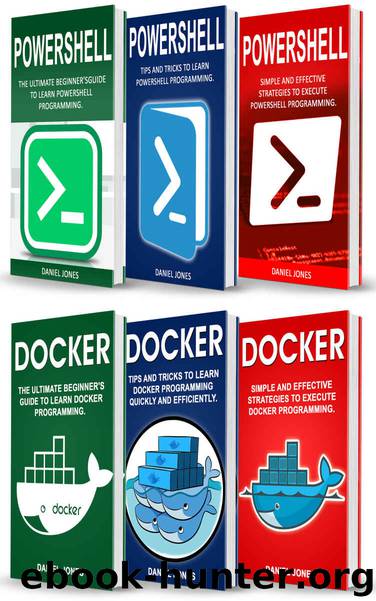Programming for Beginners: 6 Books in 1- Powershell Programming(3 Book series) & Docker Programming(3 Book series) by Daniel Jones

Author:Daniel Jones
Language: eng
Format: azw3
Published: 2017-08-29T07:00:00+00:00
Chapter 1
Docker Overview
The Docker programming language was first introduced to the public in 2013 in an open source capacity. Much like Linux, it works by using what are known as software containers which each contain all the software they need to run with minimal outside help. Once installed on a server, Docker provides everything it needs to run properly no matter what environment is being used to run it.
While there are always going to be additional layers that add abstract concepts along the way, including an automated operating system that is akin to what is running in Linux, Docker also isolates the resources required to use it into various Linux kernels including namespaces and control groups. The containers are independent of one another and each run only once to minimize the potential overhead when it comes to starting and maintaining virtual machines.
The kernels are used primarily to support the namespace by isolating the view of the environment the system is currently operating on. This goes for processes including user identification, process trees, and networks. There is even a version of Docker that uses libcontainers in its libraries which work on existing facilities to generate an abstract virtualization on the interface.
Utilizing Docker properly involves taking actions to generate base images for each system layer currently in use for the purpose of creating and documenting each layer to make it easier to repeat the process in the future. Docker ensures that each image is both lightweight and constantly as up to date as possible. As a tool, Docker can package an application along with its dependencies in a virtual container to allow it to run on any Linux server regardless of individual conditions easily. This ensures maximum portability and flexibility when it comes to where the application can run including bare metal, private clouds, public clouds, locally and more. Essentially, anywhere you choose to run it, Docker is game.
When used properly, the high-level Docker API will ensure containers are as lightweight as possible and allow processes to run in isolation. When built properly, Docker facilities allow for kernels that are different from those which run on true virtual machines. Instead, they can exist in their own sphere apart, but still a part of, any operating system that you are currently using. The operating system then uses the various kernels that have been created to use processes including the CPU and network from isolation. This, in turn, separates the namespace and provides them an isolated view of the operating system that a given application is utilizing.
Utilizing the kernels directly on a Linux system allows the use of virtualization features that uses the library directly. Additionally, the lightweight nature of the containers means that the average Docker case can utilize 5 per house at once, while it is possible to engineer things so each can run up to 10.
Download
This site does not store any files on its server. We only index and link to content provided by other sites. Please contact the content providers to delete copyright contents if any and email us, we'll remove relevant links or contents immediately.
Deep Learning with Python by François Chollet(12571)
Hello! Python by Anthony Briggs(9916)
OCA Java SE 8 Programmer I Certification Guide by Mala Gupta(9796)
The Mikado Method by Ola Ellnestam Daniel Brolund(9779)
Dependency Injection in .NET by Mark Seemann(9340)
Algorithms of the Intelligent Web by Haralambos Marmanis;Dmitry Babenko(8300)
Test-Driven iOS Development with Swift 4 by Dominik Hauser(7763)
Grails in Action by Glen Smith Peter Ledbrook(7696)
The Well-Grounded Java Developer by Benjamin J. Evans Martijn Verburg(7557)
Becoming a Dynamics 365 Finance and Supply Chain Solution Architect by Brent Dawson(7087)
Microservices with Go by Alexander Shuiskov(6856)
Practical Design Patterns for Java Developers by Miroslav Wengner(6775)
Test Automation Engineering Handbook by Manikandan Sambamurthy(6714)
Secrets of the JavaScript Ninja by John Resig Bear Bibeault(6419)
Angular Projects - Third Edition by Aristeidis Bampakos(6123)
The Art of Crafting User Stories by The Art of Crafting User Stories(5649)
NetSuite for Consultants - Second Edition by Peter Ries(5583)
Demystifying Cryptography with OpenSSL 3.0 by Alexei Khlebnikov(5389)
Kotlin in Action by Dmitry Jemerov(5066)
